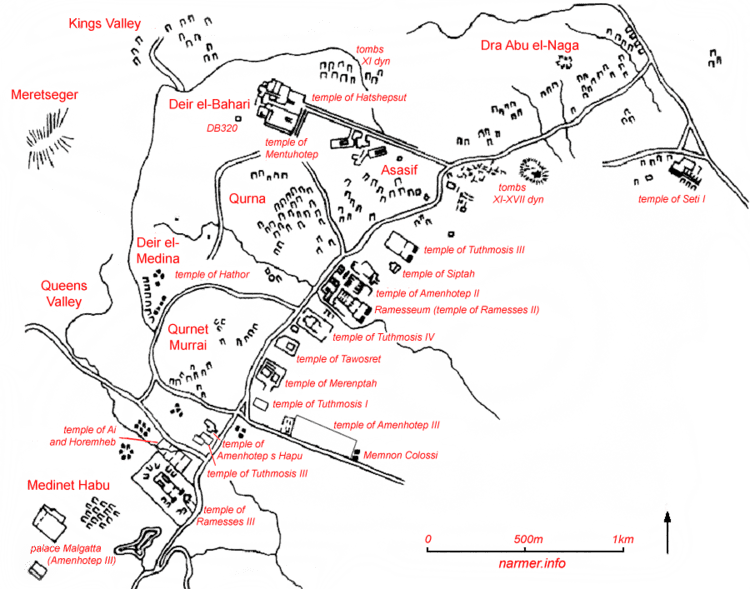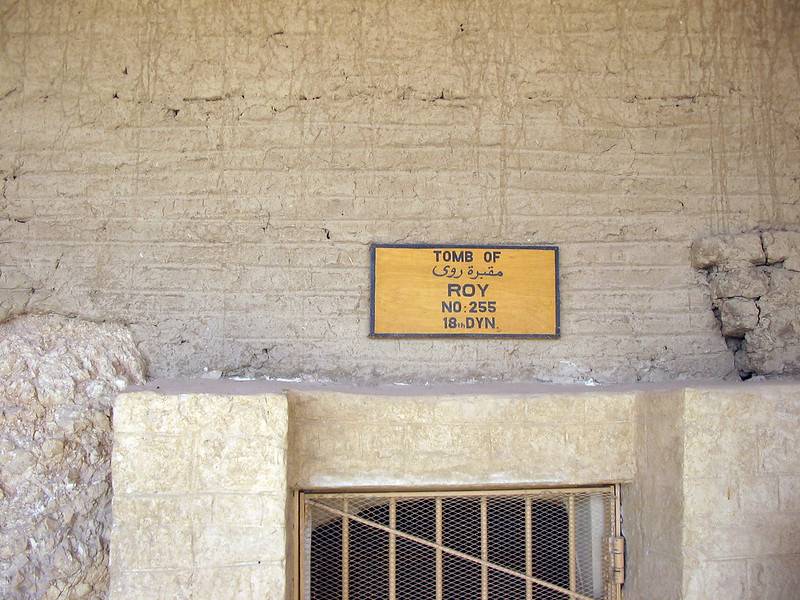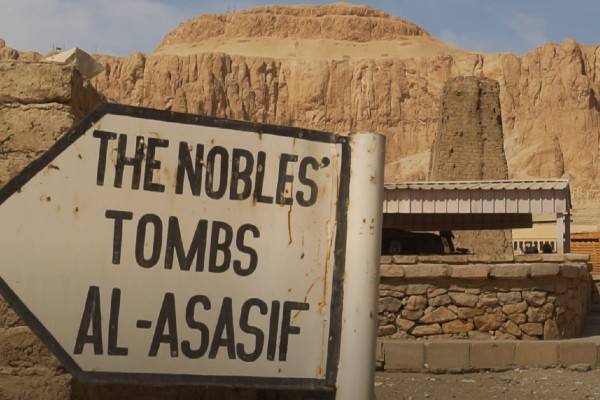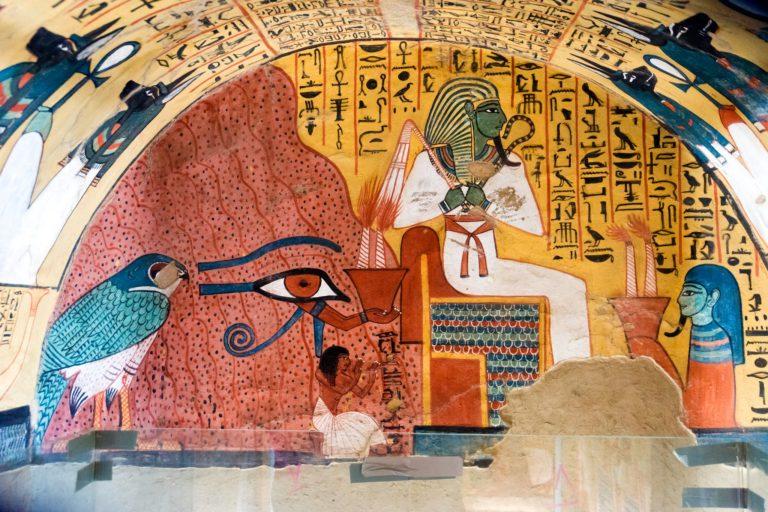Dra’ Abu el-Naga
DRA’ ABU EL-NAGA necropolis
One of the most important parts of the Theban necropolis, called Dra’ Abu el-Naga, stretches from the mouth of the Valley of the Kings on the north to the entrance of the valley leading to el-Asasif and Deir el-Bahri in the south. In general, the area is divided into Dra’ Abu el-Naga North and South, with a between the two. More detailed and precise designations of specific points are as follows from north to south: (1) Khawi el-Alamat, a wadi leading to one of the supposed early royal 18th Dynasty tombs; (2) the so-called “main hill”; (3) the region around and below the Coptic monastery of Deir el-Bakhit; (4) the wadi called “Shig elAteyat”; and (5) the hillside and plain of “el-Mandara.”

The history of Dra’ Abu el-Naga starts with the beginning of the 17th Dynasty. Since the excavations of Auguste Mariette, Giuseppe Passalaqua, Flinders Petrie, the Marquis of Northampton, and Howard Carter and Lord Carnarvon beginning in the nineteenth century, it has been known that royal and private cemeteries of the 17th Dynasty were situated at Dra’ Abu el-Naga. Numerous important artifacts of private and royal burials went to various museums, but the unpublished notes and manuscripts of the excavators gave no precise description of the location of the important royal tombs.

Studying these notes in comparison with the pharaonic description of the site in the famous Tomb Robbery Papyri of the 20th Dynasty, H.E.Winlock published a noteworthy article in 1924. His results suggest that the royal tombs were situated more or less at the foot of the Dra’ Abu el-Naga hills, in the close vicinity of the private tombs, and arranged like the itinerary order of the ancient papyri. After surveying the area in 1989, Friederike Kampp pointed out that the royal tombs would be more likely located in the upper regions of the site.

The cemeteries of Dra’ Abu el-Naga lost most of their importance from the reign of Hatshepsut until the end of the 18th Dynasty.
Luxor Tours & Activities
Looking to save some costs on your travel? Why not join a shared group tour to explore Luxor, Egypt? Here are some activities you might be interested in:
She offers the following reasons for this: (1) there should be some distance between the royal and the private cemeteries, and it is unlikely that private tombs would be situated “behind” royal tombs of the same period, which would be the case in Winlock’s proposal; (2) in the regions of Khawi el-Alamat and the “main hill” rock-cut tombs resembling the corridor saff-tombs of the Middle Kingdom were recorded, but show such architectural modifications as to be interpreted as a consequent development of the former shape of the Middle Kingdom type; and (3) almost at the top of the “main hill,” near the Coptic monastery of Deir el-Bakhit, there are three extraordinary huge tombs, which most likely are 17th Dynasty royal tombs. These latter consist of a large courtyard with a boundary wall at the front, followed by a kind of vestibule, and then by one single-pillared room, in whose middle opens an enormous deep shaft.

At about the same time as Kampp, Daniel Polz came to similar conclusions; he now hopes to find further proof from excavations at the site. Polz has excavated part of a cemetery in front of Khawi el-Alamat, where he discovered tomb structures comparable to the lost tomb of Tetiky (TT 15) in the plain of el-Mandara. The basic layout of these tombs consists of a trapezoidal courtyard, surrounded by a mudbrick wall, with a shaft in the middle of the court and a mudbrick building serving as a cult chapel west of the shaft, but inside the courtyard. The cemeteries of Dra’ Abu el-Naga lost most of their importance from the reign of Hatshepsut until the end of the 18th Dynasty.

Nevertheless, some officials were buried in Dra’ Abu el-Naga and hundreds of minor tombs have been constructed so that this part of the necropolis shows one of the densest concentrations of tombs in the whole Theban area. Recent excavations on the “main hill” proved that besides the tomb of Huy (TT 40) and the one of Nay (TT 271) at Qurnet Murai, one of the earliest tombs after the Amarna interim was erected in Dra’ Abu el-Naga. This tomb, belonging to a high priest of Amen called Parennefer, lies within a small group of tombs dating to the end of the 18th and the beginning of the 19th Dynasty. Important Rammesside tombs (19th–20th Dynasties) are to be found in the upper regions of Dra’ Abu el-Naga South at the hill of el-Mandara.

Here most of the high priests of Amen, a viceroy of Nubia, and high military officials mostly connected to the southern territories of Egypt constructed their large, elaborate tombs. Most of these tombs have mudbrick pyramids as superstructures and courtyards with pylons in front. Smaller Ramesside tombs are scattered all over Dra’ Abu el-Naga as in the other parts of the Theban necropolis. After the 20th Dynasty, a time of usurpation and reusing of tombs flourished in Dra’ Abu el-Naga as well as in the other regions of the necropolis. In the Late period, only one tomb was hewn out of the hillside at el-Mandara; the owner of this tomb used the already existing courtyard and façade of the famous tomb of Baken-khonsu (TT 35). In Ptolemaic times some tombs in the plain at the foot of the “main hill” were used to house ibis burials. From Coptic times on, the region of Dra’ Abu el-Naga was populated and the impressive ruins of the monastery at Deir el-Bakhit demonstrate its prosperity.

TT (Theban Tomb) 1 to 100
TT11 – Djehuty, overseer of the treasury under Queen Hatshepsut (18th Dynasty)
TT12 Hery, Overseer of the Granary of Queen Ahhotep (17th Dynasty) or 18th Dynasty)
TT13 – Shuroy, Chief of the Brazier-bearers of Amun (20th Dynasty)
TT14 Huy, Priest of Amenhotep, the Image of Amun (19th Dynasty)
TT15 Tetiky, son of Rahotep, mayor of Thebes (18th Dynasty)
TT16 Panehsy, Prophet of Amenhotep of the Forecourt (19th Dynasty)
TT17 Nebamun, Scribe and Physician of the King (18th Dynasty)
TT18 Baki, Chief Weigher of the Gold of Amun (18th Dynasty)
TT19 Amenmose, First Prophet of Amenhotep of the Forecourt (20th Dynasty)
TT20 Montukherkhopshef, mayor of Busiris (18th Dynasty)
TT (Theban Tomb) 101 to 200
TT140 Kefia, also called Neferronpet, goldworker and portrait sculptor (18th Dynasty)
TT141 Bakenkhons, wab-priest at the fore of Amun (Ramesside Period)
TT142 Samut, overseer of works of Amun-Ra in Karnak (18th Dynasty)
TT143 Unknown.
TT144 Nu, overseer of estate labor (18th Dynasty)
TT145 Nebamon, head of bowmen (18th Dynasty)
TT146 Nebamon, overseer of the granary of Amun, counter of grain, iny of the God’s Wife (18th Dynasty)
TT147 possibly Heby. scribe who counts the cattle of Amun of Upper and Lower Egypt, Head Elder of the portal in Karnak
TT148 Amenemopet, priest of Amun (Ramesside Period)
TT149 Amenmose, royal scribe of the table of the Lord of the Two Lands, overseer of hunters of Amun (Ramesside Period)
TT150 Userhet, overseer of cattle of Amun (18th Dynasty)
TT151 Hety, scribe, counter of cattle of the God’s Wife of Amun, steward of the God’s Wife of Amun (18th Dynasty)
TT152 Unknown. (originally built in the 18th Dynasty but usurped during the Ramesside Period.)
TT153 Unknown.
TT154 Tati, cupbearer (18th Dynasty)
TT155 Intef, great herald of the kind (18th Dynasty)
TT156 Pennesuttawy, captain of troops, governor of the South Lands (19th Dynasty)
TT157 Nebwenenef, high priest of Amun (19th Dynasty)
TT158 Thonefer, third prophet of Amun (20th Dynasty)
TT159 Raia, fourth priest of Amun (20th Dynasty)
TT160 Besenmut, true king’s acquaintance (26th Dynasty)
TT161 Nakht, bearer of floral offerings of Amun (18th Dynasty)
TT162 Kenamon, mayor of Thebes, overseer of the granary of Amun (18th Dynasty)
TT163 Amenemhat, mayor of Thebes, royal scribe (19th Dynasty)
TT164 Intef, scribe of recruits (18th Dynasty)
TT165 Nehemaway, goldsmith (18th Dynasty)
TT166 Ramose, overseer of works in Karnak, overseer of cattle (late 18th Dynasty and early 19th Dynasty)
TT167 Unknown.(18th Dynasty)
TT168 Any, Divine Father clean of hands, chosen lector of the lord of the gods (19th Dynasty)
TT169 Senena, head goldsmith of Amun (18th Dynasty)
TT (Theban Tomb) 201 to 300
TT231 Nebamun, scribe, counter of grain of Amun in the granary of divine offerings (18th Dynasty)
TT232 Tharwas, scribe of the divine seal of the Amun treasury (Ramesside Period)
TT233 Saroy and Amenhotep, Royal Scribe of the offering table of the Lord of the Two Lands, Royal Scribe of the king’s repast, Keeper of the royal documents in the presence (of the king), Leader of the Festival, Cattle Counter in the Estate of Amun, Royal Messenger to the hill country, Overseer of the hunters of Amun (Ramesside Period)
TT234 Roy, mayor (18th Dynasty)
TT236 Hornakht, second prophet of Amun and overseer of the treasury of Amun (Ramesside Period)
TT237 Wennefer, chief lector-priest (Ramesside Period)
TT241 Ahmose, Scribe of divine writings, Child of the nursery, Head of the mysteries in the House of the morning (18th Dynasty)
TT255 Roy, Royal Scribe, Steward of the estates of Horemheb and Amun (18th Dynasty)
TT260 User, Scribe, Weigher of Amun, overseer of fields of Amun (18th Dynasty)
TT261 Khaemwaset, wab-priest of Amenhotep I (18th Dynasty)
TT262 Unknown. overseer of fields (18th Dynasty)
TT282 Nakhtmin (Troop Commander) Head of the bowmen, Overseer of the South Lands (19th Dynasty)
TT283 Roma, also called Roy, high priest of Amun (19th Dynasty)
TT284 Pahemnetjer, scribe of offerings of all gods (Ramesside Period)
TT285 Iny, head of the magazines of Mut (Ramesside Period)
TT286 Niay, scribe of the table (Ramesside Period)
TT287 Pendua, wab-priest of Amun (Ramesside Period)
TT288 Bakenkhons, scribe of divine book of Khons (Ramesside Period)
TT289 Setau, viceroy of Kush, overseer of the South Lands, chief bowman of Kush (19th Dynasty)
TT293 Ramessesnakht, high priest of Amun (20th Dynasty)
TT300 Anhotep, viceroy of Kush (19th Dynasty)
TT (Theban Tomb) 301 to 400
TT301 Hori, scribe of the table of Pharaoh in the Amun domain (Ramesside Period)
TT302 Paraemheb, overseer of the magazine (Ramesside Period)
TT303 Paser, head of the magazine of Amun, Third Prophet of Amun (Ramesside Period)
TT304 Piay, scribe of the offering-table of Amun, scribe of the Lord of the Two Lands (Ramesside Period)
TT305 Paser, wab-priest in front of Amun (Ramesside Period)
TT306 Irdjanen, door-opener of the Amun domain (Ramesside Period)
TT307 Thonefer (Ramesside Period)
TT332 Penrenutet, chief watchman of the granary of the Amun domain (Ramesside Period)
TT333 and TT334 both unknown. (18th Dynasty)
TT344 Piay, overseer of the cattle [9][6](Ramesside Period)
TT375, TT376, TT377, TT378, and TT379, all unknown (Ramesside Period)
TT393 and TT396 unknown (18th Dynasty)
TT394 and TT395 unknown (Ramesside Period)
TT (Theban Tomb) 401 to 415
TT401 Nebseni, overseer of goldsmiths of Amun (18th Dynasty)
TT402 unknown (18th Dynasty)






